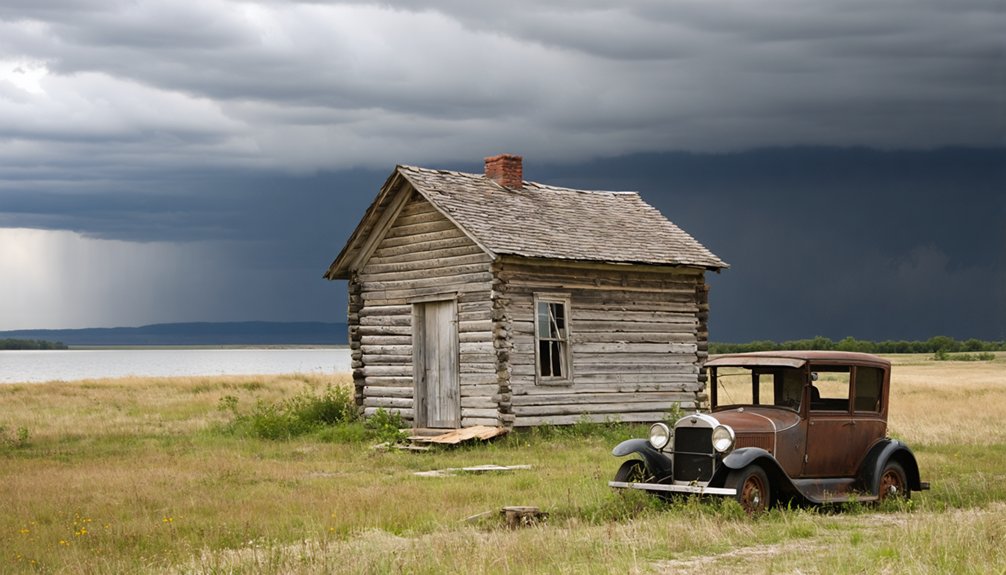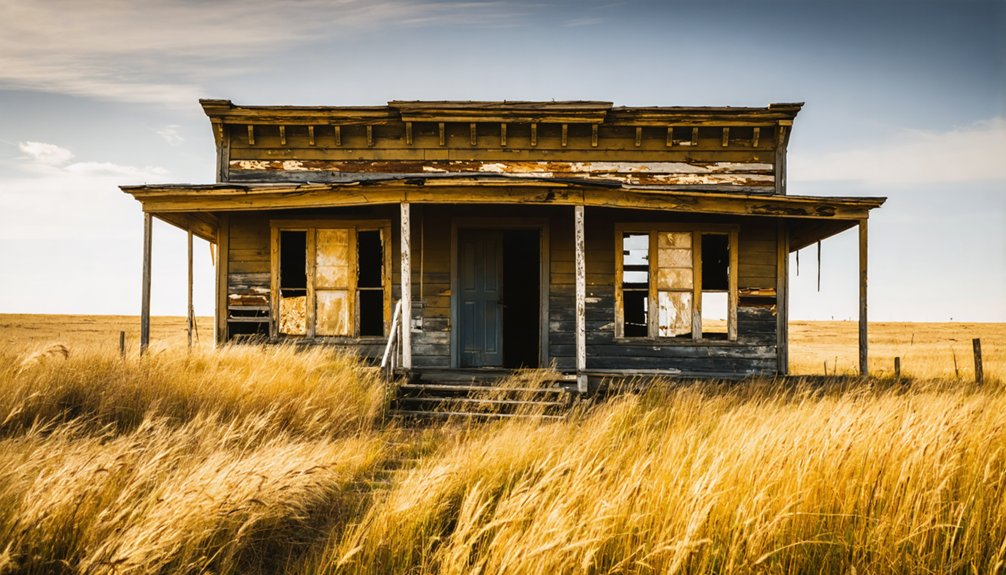You’ll find Lakeview’s weathered structures scattered across South Dakota’s prairie landscape, a tribute to Dutch immigrant farming life from 1913. Originally thriving with log cabins, churches, and schools seven miles from the nearest railroad hub, the town declined after its post office closed in 1955. While private land restrictions limit exploration today, the site’s rusting equipment, brick ruins, and nearby cemetery reveal compelling stories of early 20th-century frontier settlement patterns.
Key Takeaways
- Lakeview was established in 1913 as a frontier settlement near a steam locomotive maintenance site, serving dispersed farming populations.
- The town’s decline began with the post office closure in 1955, driven by transportation changes and economic shifts to larger towns.
- Mining company land acquisitions and population migration to urban areas contributed significantly to Lakeview’s abandonment.
- Remnants include weathered structures, dilapidated wooden buildings, and overgrown railroad tracks, though most land is now privately owned.
- Archaeological sites and oral histories preserve Lakeview’s cultural heritage, offering insights into early 20th-century prairie life.
The Dutch Agricultural Roots
A wave of Dutch settlers, initially sparse in numbers, began transforming South Dakota’s agricultural landscape in the late 19th century.
You’ll find their story remarkable – starting with just eight Dutch settlers in 1870, they quickly established thriving agricultural communities in places like Bon Homme, Turner, and Minnehaha counties.
These pioneers brought their traditional Dutch farming expertise to the challenging Great Plains environment.
You’ll see their influence in the practical methods they used: breaking tough prairie ground with oxen, introducing iron tools, and implementing smart crop diversification.
Through community building, they shared knowledge and supported each other’s success.
Their determination paid off – by the early 1880s, Dutch farmers were prospering, particularly in Turner County, where their agricultural innovations helped establish stable, productive farmland.
Some Dutch settlers like Douwe J. Zylstra later moved westward from South Dakota to establish new farming communities in places like Lynden, Washington.
Historical Settlement and Development
Building upon the Dutch agricultural heritage, Lakeview emerged as one of South Dakota’s frontier settlements during the region’s homesteading era.
You’ll find its settlement patterns followed the typical framework of rural communities that sprang up to serve dispersed farming populations, though exact founding dates remain elusive in historical records.
While the town never developed into a major rail hub, it established the essential infrastructure you’d expect in a frontier community. Like many settlements that would become ghost towns, Lakeview’s development was tied to the economic prospects of its time.
Though lacking major railway connections, Lakeview developed the fundamental services and structures typical of South Dakota’s frontier settlements.
A schoolhouse served as both an educational center and gathering place, while a general store met the basic needs of surrounding farms.
The community dynamics reflected the broader agricultural rhythm of the plains, with Dutch immigrant families forming tight-knit social bonds as they worked to build a sustainable farming community.
Life in Early Lakeview
While frontier life presented numerous challenges, early Lakeview settlers established a resilient community centered around farming and local trade. You’d find them living in log cabins built from local timber, working together to survive the harsh Dakota environment. Their daily routines revolved around subsistence farming, hunting, and fishing in the nearby lakes. The rich, stoneless soil from the ancient Lake Dakota made farming particularly productive in the region.
Settler interactions weren’t limited to just neighbors – they’d occasionally engage with Sioux peoples, learning valuable survival strategies. Community traditions emerged through gatherings at churches and one-room schoolhouses, where you’d see families celebrating harvests and sharing resources. Early residents often sold their fish catches in towns like Yankton, providing crucial income during their isolation from other markets.
When the railroad arrived in 1881, it transformed their isolated existence, connecting them to broader markets and bringing new opportunities. Life remained challenging, but the tight-knit community’s collaborative spirit helped them persevere through difficult times.
Factors Behind the Town’s Decline
Despite Lakeview’s early promise, several interconnected factors triggered the town’s eventual downfall. The decline of Black Hills mining dealt the first major blow, as technological advances and industry consolidation shifted jobs to larger towns like Deadwood and Lead. These economic impacts rippled through the community, leaving abandoned shafts and mill ruins as stark reminders of better days.
Like many other towns that followed Galena Road, the area became a ghost of its former self. You’d have seen dramatic population shifts as transportation changes bypassed the town, eliminating its strategic position. The rise of automotive transport and rerouted railroads further isolated Lakeview from crucial trade routes. Similar to Trojan’s fate, many residents chose to pursue employment at the Homestake mining operation.
Young residents left for urban opportunities, while those who remained faced a struggling single-industry economy. When mining companies began buying up local properties, many residents relocated entirely, taking their buildings with them.
Remnants and Physical Features
Modern visitors to Lakeview’s remains will find a haunting collection of weathered structures scattered across the prairie landscape. Along the overgrown railroad tracks, you’ll discover remnant structures including dilapidated wooden buildings and brick ruins with partially standing walls. Visitors must view any remaining sights from public roads only, similar to restrictions in other ghost towns.
Similar to Awanka’s decline, the town’s abandonment was largely due to better roads elsewhere and increased automobile use in the region.
The site’s most notable features include a small wooden church and several abandoned houses showing decades of neglect.
You’ll need permission to explore, as most physical artifacts and structures now sit on private land marked by “No Trespassing” signs.
Near Cottonwood Creek, nature has steadily reclaimed the town site, with native grasses and wildlife returning to spaces between old foundations and footings.
A nearby cemetery offers glimpses into the community’s past, while rusting equipment and weathered signs serve as silent witnesses to Lakeview’s former liveliness.
Modern Educational Legacy
Lakeview’s abandoned schoolhouse stands as a tribute to South Dakota’s early rural education system, sparking educational initiatives that continue today.
You’ll find the ghost town’s legacy preserved through educational tourism programs that guide visitors through the remnants while teaching about settlement patterns and economic shifts in the region.
The town’s historical records and artifacts are now valuable archival resources, housed in South Dakota’s archives and local museums.
You can explore these collections to understand frontier education and rural life in the early 20th century.
Today’s students engage with Lakeview’s history through social studies curricula, heritage festivals, and research projects that examine themes of boom-bust cycles and rural migration.
The town’s educational story lives on through community memory, interpretive programs, and academic studies of rural American life.
Comparison With Regional Ghost Towns

Within South Dakota’s rich tapestry of abandoned settlements, Lakeview stands out for its distinct pattern of decline compared to other regional ghost towns. Unlike mining-based towns like Maitland or Golden West that died when resources were depleted, or railroad-dependent communities like Okaton and Cottonwood, Lakeview’s fate wasn’t tied to a single industry’s collapse.
Like many towns established along railroad service routes, Lakeview was strategically positioned seven miles from the nearest settlement to accommodate steam locomotive maintenance needs.
You’ll find that while ghost town tourism has preserved some Black Hills communities through roadside attractions and historical tours celebrating mining heritage, Lakeview’s post office closure in 1955 and drained lake left fewer tangible remnants for visitors.
This contrasts with towns like Okaton, where you can still see wooden grain elevators, or former mining settlements with their stone banks and mill ruins standing as evidence of their industrial past.
Cultural Impact and Heritage
Despite its physical disappearance from South Dakota’s landscape, the cultural heritage of Lakeview endures through oral histories, preserved records, and agricultural traditions dating back to its 1913 founding.
The town’s legacy, centered around its namesake lake and post office operations until 1955, represents a crucial chapter in the region’s settlement history.
You’ll find Lakeview’s cultural preservation efforts manifest in several ways:
- Community memory preserved through documented stories of former residents
- Archaeological sites that offer glimpses into early 20th-century prairie life
- Educational opportunities for understanding rural development and decline
- Potential for heritage tourism and historical reenactments
These elements combine to maintain Lakeview’s significance as more than just another ghost town – it’s a reflection of the pioneering spirit that shaped South Dakota’s identity.
Frequently Asked Questions
Are There Any Surviving Photographs of Lakeview During Its Active Years?
You won’t find historical photography of active-era Lakeview in any known public archives. While private collections might exist, there’s no documented evidence of surviving photographs from the town’s operational period.
Did Any Notable Historical Figures or Events Originate From Lakeview?
You won’t find any famous residents or historical milestones linked to Lakeview. Records don’t show any notable figures or significant events during the town’s brief existence from 1913 to 1955.
What Happened to the Original Dutch Families After Leaving Lakeview?
You’ll find these resilient families sought greener pastures westward, particularly in Washington state, where their family migration patterns created lasting Dutch settlements, maintaining cultural impact through religious traditions and agricultural communities.
Are There Any Documented Paranormal Activities or Local Legends About Lakeview?
You won’t find documented ghost sightings or local folklore about this place. Despite many South Dakota ghost towns having paranormal tales, there’s no credible evidence of supernatural activity here.
Can Visitors Legally Explore the Remaining Structures of Lakeview Today?
You’ll need landowner permission for legal access to any remaining structures, as visitor restrictions apply. Without clear ownership information or public designation, exploring these buildings could constitute criminal trespassing.
References
- https://www.southdakotamagazine.com/one-man-towns
- https://www.sdpb.org/rural-life-and-history/2023-08-21/some-black-hills-ghost-towns-and-their-origins
- https://www.sdhspress.com/journal/south-dakota-history-2-2/some-black-hills-ghost-towns-and-their-origins/vol-02-no-2-some-black-hills-ghost-towns-and-their-origins.pdf
- https://www.youtube.com/watch?v=_0WNYsFLSLA
- https://www.blackhillsbadlands.com/blog/post/old-west-legends-mines-ghost-towns-route-reimagined/
- https://aberdeenmag.com/2019/01/the-ghost-towns-of-brown-county/
- https://en.wikipedia.org/wiki/List_of_ghost_towns_in_South_Dakota
- https://www.ghosttowns.com/states/sd/lakeviewandpurewater.html
- https://973kkrc.com/south-dakota-underwater-ghost-town/
- https://www.onlyinyourstate.com/experiences/south-dakota/capa-ghost-town-sd



